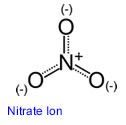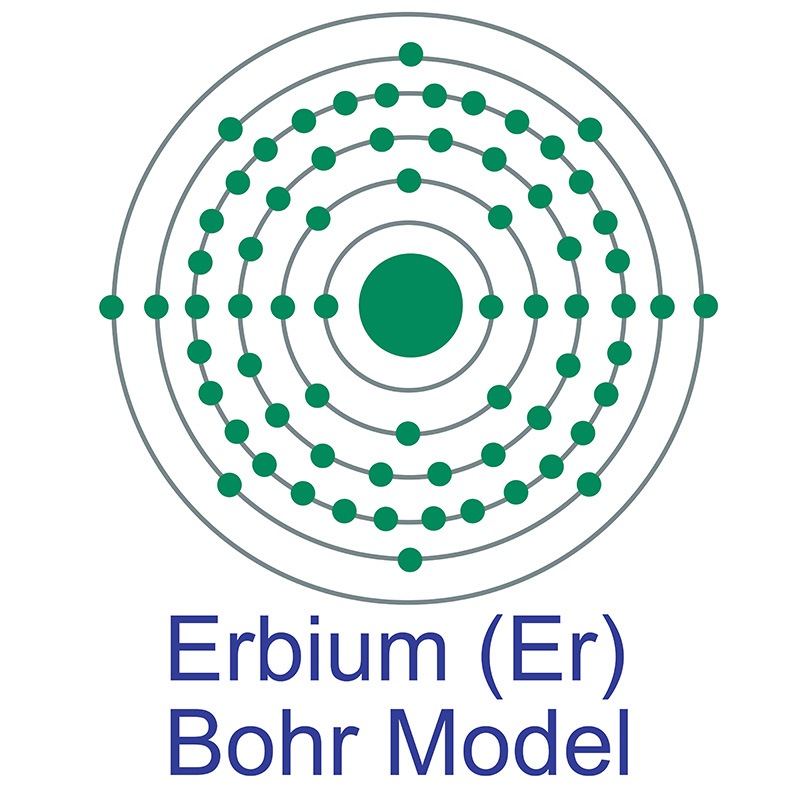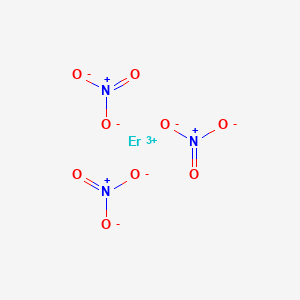SECTION 1. IDENTIFICATION
Product Name: Erbium Nitrate
Product Number: All applicable American Elements product codes, e.g. ER-NAT-04
, ER-NAT-05
, ER-NAT-02
, ER-NAT-03
CAS #: 10168-80-6
Relevant identified uses of the substance: Scientific research and development
Supplier details:
American Elements
10884 Weyburn Ave.
Los Angeles, CA 90024
Tel: +1 310-208-0551
Fax: +1 310-208-0351
Emergency telephone number:
Domestic, North America: +1 800-424-9300
International: +1 703-527-3887
SECTION 2. HAZARDS IDENTIFICATION
Statements of Hazard: Irritant, Oxidizer
Acute Health Hazard: Irritant to eyes, skin, mucous membranes and
respiratory system. May be harmful by ingestion,
inhalation or skin absorption.
Chronic Health Hazard: Not Available
HMIS Rating: H:0 F:0 P:1
NFPA Rating: H:0 F:0 R:1
To the best of our knowledge, the toxicological properties of this chemical have not
been thoroughly investigated. Use appropriate procedures and precautions to prevent
or minimize exposure.


Pictogram:
Signal Word: Danger
Hazard Statement(s): H272 May intensify fire; oxidizer.
H302 Harmful if swallowed.
H312 Harmful in contact with skin.
H315 Causes skin irritation.
H319 Causes serious eye irritation.
H332 Harmful if inhaled.
H335 May cause respiratory irritation.
Precautionary Statement(s): P210 Keep away from heat/sparks/open flames/hot
surfaces. — No smoking.
P220 Keep/Store away from clothing/combustible
materials.
P221 Take any precaution to avoid mixing with
combustibles
P261 Avoid breathing dust/ fume/ gas/ mist/
vapors/ spray.
P280 Wear protective gloves/protective clothing/eye
protection/face protection.
P301+P312 IF SWALLOWED: Call a POISON
CENTER or doctor/physician if you feel unwell.
P302+P352 IF ON SKIN: Wash with plenty of soap
and water.
P304+P340 IF INHALED: Remove victim to fresh air
and keep at rest in a position comfortable for
breathing.
P305+P351+P338 IF IN EYES: Rinse cautiously
with water for several minutes. Remove contact
lenses, if present and easy to do. Continue rinsing.
P332+P313 If skin irritation occurs: Get medical
advice/ attention.
SECTION 3. COMPOSITION/INFORMATION ON INGREDIENTS
Chemical Name: Erbium nitrate
Synonyms: Not Available
CAS Number: 10168-80-6
MDL Number: MFCD00149691
EINECS Number: Not Available
Belstein Registry Number: Not Available
Molecular Formula: Er(NO3)3.5H2O
Molecular Weight: 443.35
Content: 99%
Notes: Not Available
SECTION 4. FIRST AID MEASURES
Eye Contact: Flush eyes with large amounts of water for fifteen
minutes. Separate eyelids with fingers. If irritation
persists, seek medical attention.
Skin Contact: Wash skin with soap and water. If irritation persists,
seek medical attention.
Ingestion: Do not induce vomiting. Seek medical attention.
Inhalation: Move to a fresh air environment. Contact a physician
if breathing becomes difficult.
SECTION 5. FIREFIGHTING MEASURES
Flash Point: Not Available
Explosion Limits: Lower: Not Available
Upper: Not Available
Autoignition: Not Available
Extinguishing Media: Carbon dioxide, dry chemical powder, alcoholresistant
foam or water spray.
Protective Equipment: Wear self-contained respirator and fully protective
impervious suit.
Specific Hazards: May emit hazardous fumes under fire conditions. May
intensify fire.
SECTION 6. ACCIDENTAL RELEASE MEASURES
Personal Protection: Wear a self-contained breathing apparatus, rubber
boots and gloves, and disposable coveralls. Dispose of
coveralls after use.
Keep unprotected persons away.
Environmental Protection: Keep spills out of sewers and bodies of water. Dike
and contain the spill with inert material. Absorb on
sand, vermiculite or diatomite. Transfer material to a
container for disposal or recovery. Ventilate area and
wash spill site after material pickup is complete.
SECTION 7. HANDLING AND STORAGE
Handling: Avoid breathing dust, vapor, mist or gas. Avoid
contact with skin and eyes. Avoid prolonged or
repeated exposure. Use only in a chemical fume
hood. Open and handle container with care. Keep
ignition sources away.
Storage: Store in a tightly closed container in a dry, wellventilated
place. Store away from reducing agents
and organic materials.
Sensitivities: Not Available
Storage Temperature: 15 – 30 ºC
SECTION 8. EXPOSURE CONTROLS/PERSONAL PROTECTION
Eyes: Wear appropriate protective eyeglass or chemical
safety goggles. Make sure that there is an eyewash
facility in your vicinity.
Skin: Wear impervious gloves and protective clothing.
Respiratory: Use a NIOSH approved respirator when exposure
limits are exceeded or if irritation or other symptoms
are experienced.
Exposure Limits: Country Source Type Value
USA ACGIH TWA Not Available
USA OSHA STEL Not Available
USA OSHA PEL Not Available
SECTION 9. PHYSICAL AND CHEMICAL PROPERTIES
Appearance: Solid
Odor: Not Available
Melting Point: Not Available
Boiling Point: Not Available
pH Value: Not Available
Density: Not Available
Refractive Index, n20
D: Not Available
Viscosity: Not Available
Solubility in Water: Soluble
Vapor Pressure: Not Available
Vapor Density(Air=1): Not Available
SECTION 10. STABILITY AND REACTIVITY
Stability: Stable under normal temperatures and pressures.
Incompatibility: Strong reducing agents, Organic materials.
Conditions to Avoid: Heat, Flame, Sparks, Other ignition sources
Hazardous Decomposition Products: Erbium oxides, Nitrogen oxides
SECTION 11. TOXICOLOGICAL INFORMATION
RTECS Reference: Not Available
Target Organs: Not Available
Toxicity Data: Not Available
Skin corrosion/irritation: Not Available
Serious eye damage/irritation: Not Available
Carcinogenicity: Not Available
SECTION 12. ECOLOGICAL INFORMATION
Toxicity: Not Available
Persistence and degradability: Not Available
Bioaccumulative potential: Not Available
Mobility in soil: Not Available
PBT and vPvB assessment: Not Available
Other adverse effects: Not Available
SECTION 13. DISPOSAL CONSIDERATIONS
Contact a licensed professional waste disposal service. Dispose in a manner consistent
with federal, state and local environmental regulations.
SECTION 14. TRANSPORT INFORMATION
DOT Shipping Name: Nitrates, Inorganic, N.O.S.
DOT UN Number: UN1477
DOT Hazard Class: Class 5.1
DOT Packing Group: II
IMDG Shipping Name: Nitrates, Inorganic, N.O.S.
IMDG UN Number: UN1477
IMDG Hazard Class: Class 5.1
IMDG Packing Group: II
IATA Shipping Name: Nitrates, Inorganic, N.O.S.
IATA UN Number: UN1477
IATA Hazard Class: Class 5.1
IATA Packing Group: II
SECTION 15. REGULATORY INFORMATION
United States:
Toxic Substance Control Act (TSCA): Listed
Superfund Amendments and Reauthorization Act (SARA 302): Not listed
Superfund Amendments and Reauthorization Act (SARA 311/312): Listed
Superfund Amendments and Reauthorization Act (SARA 313): Not listed
European Union:
European Inventory of Existing Chemical Substances (EINECS): Not Available
Hazard Codes: O, Xi
Risk Statements: 8-41
Safety Statements: 17-26-39
Canada
Canadian Domestic Substances List (DSL): Not listed
Canadian Domestic Substances List (NDSL): Not listed
SECTION 16. OTHER INFORMATION
Safety Data Sheet according to Regulation (EC) No. 1907/2006 (REACH). The above information is believed to be correct but does not purport to be all inclusive and shall be used only as a guide. The information in this document is based on the present state of our knowledge and is applicable to the product with regard to appropriate safety precautions. It does not represent any guarantee of the properties of the product. American Elements shall not be held liable for any damage resulting from handling or from contact with the above product. See reverse side of invoice or packing slip for additional terms and conditions of sale. COPYRIGHT 1997-2022 AMERICAN ELEMENTS. LICENSED GRANTED TO MAKE UNLIMITED PAPER COPIES FOR INTERNAL USE ONLY.


 The number of electrons in each of Erbium's shells is [2, 8, 18, 30, 8, 2] and its electron configuration is [Xe]4f12 6s2. The erbium atom has a radius of 176 pm and a Van der Waals radius of 235 pm. Erbium was discovered by Carl Mosander in 1843. Sources of Erbium include the mineral monazite and sand ores. Erbium is a member of the lanthanide or
The number of electrons in each of Erbium's shells is [2, 8, 18, 30, 8, 2] and its electron configuration is [Xe]4f12 6s2. The erbium atom has a radius of 176 pm and a Van der Waals radius of 235 pm. Erbium was discovered by Carl Mosander in 1843. Sources of Erbium include the mineral monazite and sand ores. Erbium is a member of the lanthanide or  In its elemental form, erbium is soft and malleable. It is fairly stable in air and does not oxidize as rapidly as some of the other rare earth metals. Erbium's ions fluoresce in a bright pink color, making them highly useful for imaging and
In its elemental form, erbium is soft and malleable. It is fairly stable in air and does not oxidize as rapidly as some of the other rare earth metals. Erbium's ions fluoresce in a bright pink color, making them highly useful for imaging and 
